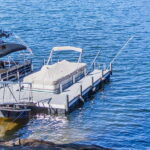Do you want your boat to be ready for use all year round? Wet storage might sound appealing, but is storing your boat in the water during winter a wise move? Let’s find out.
You can leave your boat in the water during winter or for the whole year only if you are ready to take precautions to face the challenges of a boat staying in the water for extended periods. You should, however, remember that wet storage poses far more challenges and risks than dry storage.
It is also important to note that the type of water and temperature are vital deciding factors because warm weather increases growth and blisters, while cold weather causes freezing. Likewise, freshwater increases growth while saltwater escalates the rates of corrosion.
That said, we’ll move to the precautions you must take when storing your boat in the water. How do you best protect it? Here are the top boat winterizing tips you’ll find helpful.
Note: most links in this article are Amazon.com Affiliate links, see Affiliate Disclosure, thank you.
Invest in a Good Cover
Whether you opt for a permanent canvas cover custom-made for your boat or shrink-wrap it all year long, covering your boat is a costly investment. While you might be tempted to construct your own framing and use inexpensive tarps to save money, you ought to be careful.
A proper covering will give you peace of mind over winter. On the other hand, improvised coverings are likely to leak, loosen, or fit poorly. Any issues with your boat cover will become even more prominent with the boat in the water. If the cover loosens or falls in the water, recovering and replacing it will be tricky.
Every time you check your boat during winter, ensure you examine the cover for any signs of wear and tear and promptly address any issues. The best time to do so is after a significant ice, wind, or snow event.
Shore Power and Battery Care
For your bilge pumps to work, you’ll need battery power. Fortunately, most in-water storage locations have shore power to ensure the batteries are always fully charged. In cases where power isn’t available, you’ll need to figure out how to keep your bilge pumps working all winter.
While at it, remember that shore power connection also comes with challenges. For this reason, you might want to inspect all connections for water intrusion, freezing, and shorting signs.
Get a Heater
The water your boat is sitting in is a voluptuous heat sink that keeps the effects of cold air in your boat at bay. This is a good thing. Boats resting on the ground chill faster and are more susceptible to rapid freezing than those in water. However, this doesn’t mean that you are clear of all risks. It just means that your boat stands a chance during short freezes.
However, your boat will stay in the water all winter. As a result, it will experience more dampness and humidity than a boat on land and, therefore, will be more prone to mildew and mold. If you have shore power, create a small cabin heater in the engine room or cabin to dry out the air and prevent the interior from freezing. Still, you must winterize the systems in case of a power failure or a deep cold overwhelming the heater. Doing so reduces your risk of mold and other damage.
If you think a dehumidifier would do an equally superb job, you must think hard. Why? You will need to empty it before it freezes. This is particularly challenging when all your thru-hulls are closed.
For small boats, consider a compact dehumidifier in combination with a lizard tank heater. Placing the heater next to your bilge pump with the dehumidifier on top will keep the system from freezing and remove excess moisture from your boat.
We used this dehumidifier in our battery compartment. We modified the holding tank by drilling a small hole to allow it to drain into the bilge well.
Go for Ice Eaters
Although salt water freezes at lower temperatures than fresh water, it still might freeze in a prolonged cold spell. While your wet stored boat can withstand a thin ice film, it poses crushing risks if it thickens. Most marinas have ‘ice eaters.’ These are electric propellers in the water or a system that generates bubbles to prevent the formation of thick ice around your boat. If you can’t install such systems, ensure the dock is powered so you can install your own.
Ice eaters aren’t a failsafe solution to ice problems, but they will ensure the formation of thinner ice around your boat. This way, you significantly reduce the damage risks.

The Bilge is an Awesome Companion
Another necessity when wet storing your boat is a properly functioning bilge pump. However, if you aren’t sure you can keep your batteries charged to power a bilge pump, you should reconsider wet storage.
As for caring for your bilge, always ensure you drain and clean it. This way, there won’t be anything to block the intakes on the pump. Also, consider adding extra-strength antifreeze to prevent the pumps from being damaged. Doing so also ensures things do not freeze.
Inspect Under the Boat
Before leaving your boat out in the water, check all the sacrificial zinc to ensure they are in perfect shape to face winter. If you have any doubts, it is best to replace them. A thorough inspection is vital as stray currents that bring about galvanic corrosion tend to be found close to docks with shore power.
Pay Your Boat a Visit
If you ever forget all the above tips, then at least remember that the best way to take care of your wet-stored boat is by visiting and tending to it regularly. Damage to boats doesn’t just happen out of the blue or overnight. Instead, it is often an accumulation of days of neglect.
Every time you visit your boat, look for the following:
- The state of the battery charge. Ensure your batteries are always fully charged. If they aren’t, charge them. If you notice they are discharged, find out why.
- Water in the bilge. The presence of water in the bilge could signify outside leaks or accumulation resulting from condensation.
- Shore power connections. Check for water ingress, warmth, and signs of shorting around the connections.
- Holes, leaks, or loose spots in the boat cover
Conclusion
Leaving your boat in the water during winter comes with various challenges, and it can be risky, but it’s not impossible to do if you take the necessary precautions. In this article, we’ve outlined tips on keeping your boat safe and healthy in wet storage during the colder months.
Following these tips can help reduce the risks of damage caused by ice and corrosion. But, if you only take one tip to heart, visiting your boat regularly is the best safeguard to prevent harm or, worst yet, the unfortunate event of a sinking.
We hope these tips will help you have a great boat winter!





[…] The chances of being robbed of boat equipment are significantly reduced when the gear on your boat is hidden beneath a cover. It discourages people from looking in, and thieves may consider it more work to remove the cover than the gear is worth. These can help whether in your home driveway, public storage, or at a boat moorage dock for the winter. […]